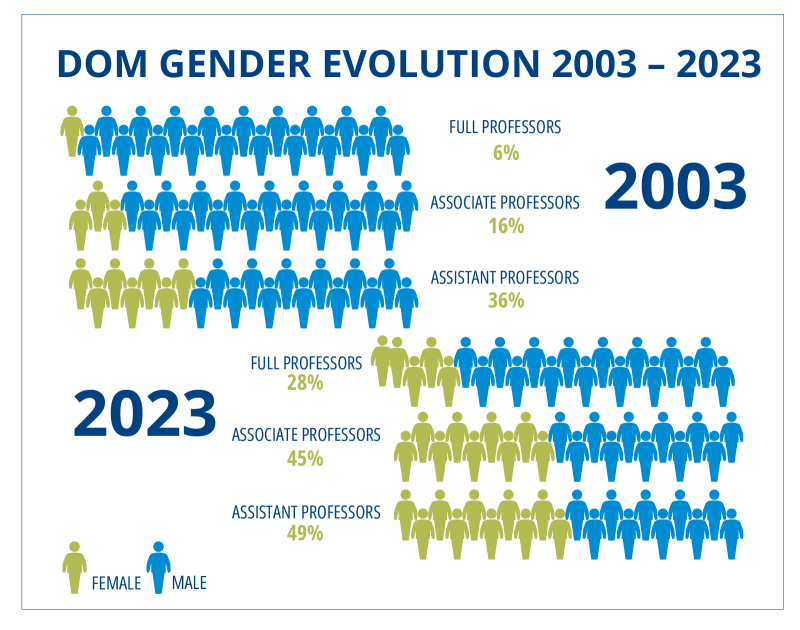
By Kathleen Cooney, MD
Chair, Department of Medicine
As we recognize Women’s History Month, I would like to share some personal reflections on the gender evolution in academic departments of internal medicine over the past 20 years. As one of the most senior women in our department, I have lived through these changes and am excited to see the progress we have made in establishing gender balance.
Twenty years ago, women represented around one quarter of the faculty in our department and there were few women who reached the status of full professor. In contrast, this year, approximately half of our assistant professors are women, and women are progressing through rank more successfully. Note that our data in the graphic above compare favorably to AAMC data from 2022 that shows women at just 46% of assistant professors, 41% of associate professors and 27% of professors, nationally1.
What are the factors contributing to the success of women in academic internal medicine? With increasing numbers of women reaching senior ranks, medical students are more likely to see female role models and potential mentors. The gender evolution in internal medicine has been congruous with many societal improvements in gender equality, including expanded parental leave policies, greater access to childcare, and more extensive salary equity policies.
However, despite the increasing numbers of women faculty members in academic internal medicine, there continues to be a glass ceiling when it comes to leadership positions. When I was a tenured associate professor 20 years ago, there were no women basic science or clinical chairs in my institution. I remember awkward meetings with our Dean on this topic; women were offered leadership training opportunities and were each given a copy of the book “Hardball for Women” to help us navigate the male-dominated workplace in healthcare!
Our achievements in research, education and clinical care are increasingly being recognized, and women are becoming more visible in the leadership ranks of departments of internal medicine. In my first two major leadership jobs, I was the only woman among twelve division chiefs and the only woman among 16 clinical department chairs, respectively. Here at Duke, there are currently four female department chairs. The DOM has three female division chiefs and they each play very important roles contributing to the success of our mission. However, although female leadership is common here at Duke, data shows that women chairs are currently leading only ~ 15% of internal medicine departments2.
I am thankful to have personally witnessed so much improvement in the opportunities for women in all areas of internal medicine, including leadership – but there’s more work to be done. I look forward to supporting men and women at all levels in medicine so that together we can continue to make progress towards achieving gender equity. We all benefit from greater diversification of our teams – and let’s lead this charge together.
Sources
1. AAMC Faculty Roster: U.S. Medical School Faculty: https://www.aamc.org/data-reports/faculty-institutions/interactive-data…
2. Data from the Academic Alliance for Internal Medicine (AAIM).